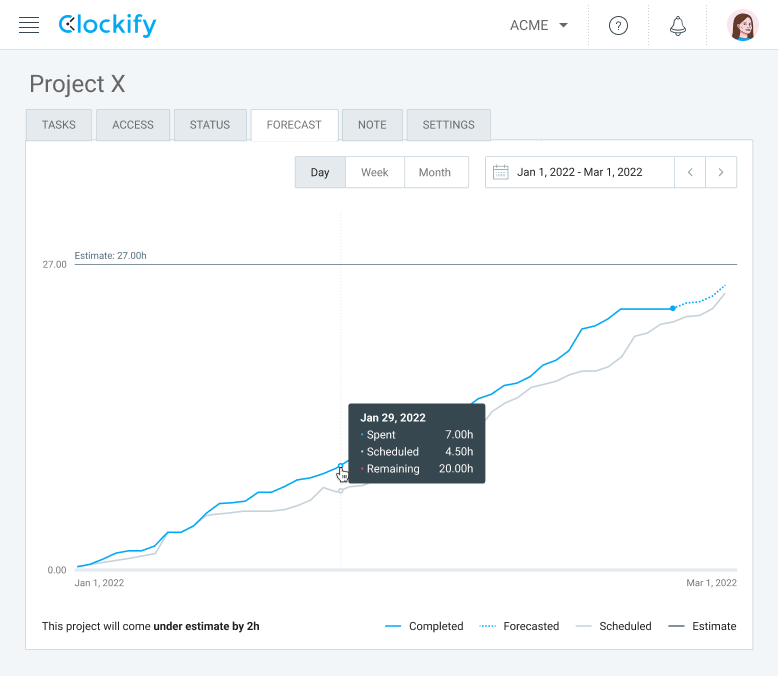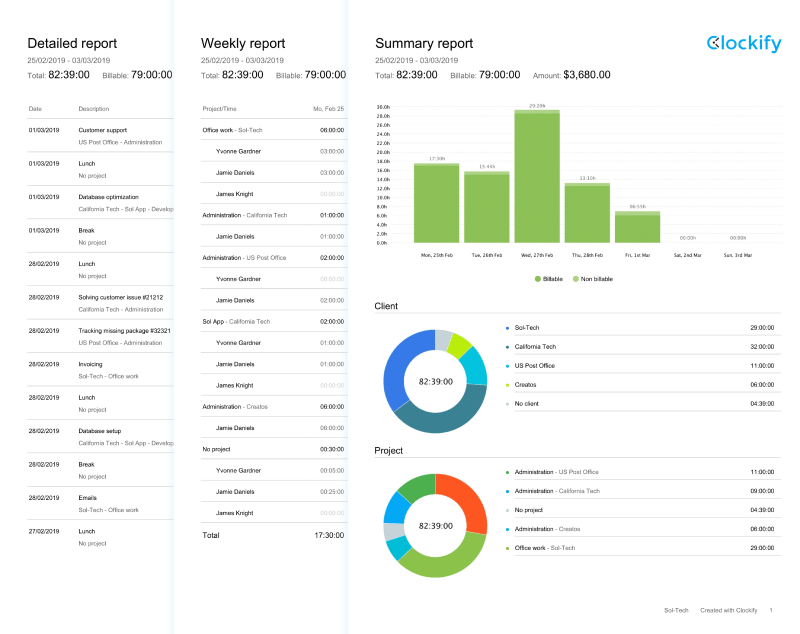Have you ever underestimated the amount of time you’ll need to complete a task or a project? Or ended up going over your original budget?
It’s highly likely that you have, even if your time management, organizational, and planning skills are on point.
Moreover, it seems that we all do this — systematically and repeatedly.
Sure, we can always blame it on Murphy’s law and take no responsibility for the wrong forecasts.
However, the truth lies in the very wiring of our brains — specifically, one type of cognitive bias called the planning fallacy.
In this article, we’ll get to the bottom of it by covering the following topics:
- What the planning fallacy is,
- How to recognize cognitive biases,
- The steps to becoming more objective, and
- The importance of time tracking in developing healthy habits and monitoring progress.
We’ll also provide real-life examples, as well as share some valuable tips and tricks to help you overcome the planning fallacy issue, so read on.

The planning fallacy phenomenon
Let’s start by defining the phenomenon which is to blame for our wishful thinking and setting unrealistic expectations and deadlines.
The term planning fallacy was introduced in 1977 by Daniel Kahneman and Amos Tversky, psychologists who tried to explain this tendency in people.
They formulated the definition of the phenomenon, saying that the planning fallacy is:
“A tendency to underestimate the time it will take to complete a project while knowing that similar projects have typically taken longer in the past. So it’s a combination of optimistic prediction about a particular case in the face of more general knowledge that would suggest otherwise.”
Simply put, the planning fallacy refers to a prediction phenomenon and unrealistic optimism in estimating the time we need to complete future tasks.
Sounds all too familiar? You shouldn’t beat yourself up about it, as it happens to the best of us.
And luckily, there are strategies to get more realistic in planning ahead.
But before we get to steps to beat the planning fallacy, let’s examine why the phenomenon even happens.
💡 Clockify Pro Tip
Want to become an expert in time estimation? Check out these tips and tricks:
Why do people tend to succumb to the planning fallacy issue?
There are several reasons why people continue to be overconfident in their predictions (even if they get it wrong every single time), such as:
- The optimism bias,
- The present bias,
- Motivation, and
- Social pressure.
Speaking from a behavioral perspective, the planning fallacy impacts 2 vital aspects of human behavior:
- Critical thinking, and
- Decision-making processes.
When the 2 aspects are impaired, we’re less likely to anticipate consequences and make correct assumptions, which makes us less rational and less likely to look at the task from different perspectives.
Moreover, our organizational and time management skills highly depend on both critical thinking and decision-making, which further increases the chances of harmful impact.
Additionally, there’s a myriad of more personalized reasons each of us can add to the list above, such as our inability to break down tasks into smaller components. That will mostly depend on specific tasks and how we feel about completing them.
Now let’s explain the connections between the planning fallacy and the key reasons from the list above.
Reason #1: Optimism bias
Optimism bias is deeply ingrained in our brains and essentially refers to a tendency to always see the glass half full.
People all over the world tend to have this illusion, so being overly optimistic is not a cultural thing, as cognitive neuroscientist Tali Sharot explains in her book The Optimism Bias: A Tour of the Irrationally Positive Brain.
Another relevant key point from the same book is that our perception of the world often relies on having positive expectations of the outcome — which is not a bad thing.
We just have to bear in mind that the outcomes won’t always be as desirable as we’d anticipated, and thus consider the what-ifs.
Interestingly, a study on optimism bias reports that the optimism bias happens to other species as well, such as birds and rats — indicating it’s a deeply rooted evolutionary phenomenon.
On the other hand, the lack of optimistic tendencies can be noticed in people suffering from depression. According to The Diagnostic and Statistical Manual of Mental Disorders, pessimism is the key symptom in a range of depression disorders.
So, what can we conclude about the connection between the planning fallacy and optimism?
Optimism is a healthy brain mechanism that helps us be happier and more confident to tackle challenges that life throws at us.
However, if we’d like to reap its benefits and avoid the planning fallacy, we must be fully aware that we’re biased. That’s the only way not to underestimate the risks and succeed in a world of uncertainty.
Reason #2: Present bias
Another bias that shapes our decision-making processes, thus enabling the existence of the planning fallacy, is the present bias.
The relationship between our past, present, and future self often comes down to seeking an immediate reward — beneficial for the present self — even if we know that the future self will regret the decision.
💡 Clockify Pro Tip
If you’d like to find out more about the present bias, this guide is a must-read:
In the context of the planning fallacy, the present bias makes it difficult to be objective about future events. In order to justify satisfying our present self, we’ll create an ideal scenario for completing the task, not accounting for any obstacles or interruptions.
Or, in the words of one of our favorite cartoon characters:
“That’s a problem for future Homer! Man, I don’t envy that guy!”
Reason #3: Motivation
There are 2 types of motivation — intrinsic and extrinsic — and they both play a role in the existence of the planning fallacy.
Intrinsic motivation is what drives us internally, the cases when our own satisfaction is the reward itself. On the other hand, extrinsic motivation revolves around external rewarding factors, such as money, praise, etc.
The connection with the planning fallacy is quite obvious here — low motivation can cripple us from taking action, but we can’t really anticipate how motivated we’ll feel in the future.
Additionally, our initial motivation levels are usually the highest at the stage when the task or a project is still abstract. That’s the moment when we’re aware of the benefits, yet still unaware of challenges such as:
- Obstacles we might encounter,
- Procrastination and its negative impacts, and
- Realization of the tasks we find unpleasant.
Therefore, we’re creating a plan or a schedule convinced the said levels would remain that high, which, unfortunately, often isn’t the case.
💡 Clockify Pro Tip
Want to step up your game and learn about different motivation methods and theories? This article can help you, so check it out:
Reason #4: Social pressure
People are inherently social creatures — our lives are shaped by the social norms, as well as our relationships and interactions with others.
We grow up in families, work in teams, and develop friendships and romantic relationships, so it’s only natural that people around us have influence on our behavior.
However, that influence can turn into pressure to fit in and conform to a specific standard.
That type of pressure is called social pressure.
Consider the following scenario:
It’s Monday, and you’re on a call with your business partner. The two of you are discussing the timeline and responsibilities for the following week, so you’re both fully aware of what needs to be done.
At some point, you make a confident statement such as “Consider it done by the end of the week!”
And then an unexpected obstacle occurs, and you end up having to take a sick day. The week goes by, and you manage to complete only 70% of the planned activities. Now you have to ask for a deadline extension, and are most likely feeling bad about it.
It’s only natural that we all want to make a good impression on other people, right? That’s where the social pressure kicks in, along with the tendency to be overly optimistic and perhaps too confident in our future selves.
However, in reality, while we want to impress others and show them just how capable we are, once again — the planning fallacy occurs, as Dyedra K C Morrissey in her doctoral thesis on the University of Oxford explains.
The reasons are many, from taking an unplanned sick day to simply the core of the planning fallacy issue — underestimating the time we needed to complete the task.
Negative effects of the planning fallacy
Making unrealistic predictions can be dangerous in both our private and professional aspects of life.
On an individual scale, for starters, it will lead us to miss deadlines and damage our reputation or relationships — by making us seem unreliable. Moreover, it can have financial consequences and lead to the deterioration of one’s mental health.
But there’s also the big picture, such as the world economy and climate change.
Here’s a (not so) fun fact: several economists and neuroscientists, including the aforementioned Tali Sharot, claim the optimism bias, so implicitly the planning fallacy as well, is “one of the core causes for the financial downfall in 2008.”
Now let’s see some other examples of negative effects of the planning fallacy issue.
Negative effect #1: Sub-optimal project results
We’ve already mentioned that the planning fallacy negatively affects our critical thinking and decision-making processes. So let’s look at the impact of setting unrealistic goals and deadlines in a business environment, specifically for project planning and realization.
When it comes to project management, some common repercussions of the planning fallacy are:
- Sub-optimal results regarding quality,
- Missed deadlines, and
- Financial damages.
The reason is that when we underestimate the time needed to complete a task, there are 2 additional factors that we don’t take into account. The said factors are:
- Negative consequences of poor decision-making, and
- Financial costs that happen due to delays in the planned schedule or inaccurate estimates.
So, the more complex the project is, the more damaging those consequences can be. Here’s to name a few examples:
- Employee dissatisfaction and turnover,
- Potential for lawsuits, and
- Bankruptcy.
That applies not only to individual projects but the overall business reputation of a company or an organization.
Negative effect #2: Decreased productivity and efficiency
Being aware we’re behind our planned schedule is simply frustrating.
We set certain expectations of our own capabilities and judgment, and when those expectations aren’t met, it’s only natural that we feel discouraged or even disappointed in ourselves.
That’s when our stress levels rise, and instead of being in the moment, we tend to worry about the future outcome.
Those negative feelings impact our motivation and as a consequence, our productivity and efficiency levels are reduced.
So on top of already not being on track, the margin of error increases, and we’re more likely to procrastinate and overthink.
Instead of blaming ourselves once again, we should remind ourselves that the original plan was faulty and unreasonably optimistic. Accepting that as a fact is the first step in beating the planning fallacy in the future.
After all, only if we’re aware of the issue can we record and later analyze the data to prevent a similar issue from happening again and get better at making precise estimates.
💡 Clockify Pro Tip
Want to become the master of productivity? Then you must check out our thorough guide:
Negative effect #3: Poor self-esteem and psychological well-being
As we’ve mentioned above, failing to meet our expectations leads directly to disappointment, overworking, and stress.
Without properly understanding the role of the planning fallacy, we’ll put the blame on ourselves and start feeling low and inadequate, and even experience the imposter syndrome.
As Tchiki Davis from Berkley Well-Being Institute explains, such feelings are directly related to low self-esteem and self-confidence.
Following on to that, one of the studies on self-esteem points out self-esteem is closely related to our psychological well-being, and an important predictor of it.
What is interesting is that’s exactly the opposite of what happens when we create the same unrealistic timeline. So, contrary to being overly enthusiastic, we end up experiencing a decrease in motivation, followed by doubt in our expertise and abilities.
💡 Clockify Pro Tip
If you’ve ever struggled with being in control of your time, the solution might be in this article:
Negative effect #4: Damaged interpersonal relationships
Apart from letting yourself down, the planning fallacy results in letting other people down. When missing deadlines and breaking promises become a pattern, everyone involved or affected will perceive you as unreliable and untrustworthy.
Both your integrity and reputation will be compromised, as you’ll be perceived as someone whose actions don’t measure up to your words and promises.
In terms of personal life, for example, you may end up being that person — whom everyone always expects to be late for family gatherings.
On the other hand, as we’ve mentioned above, the impacts of the planning fallacy in business have the potential to ruin your credibility and even result in your company failing.
One of the reasons is that there are more dependencies involved, so one delay impacts every following step.
As a consequence, your clients and business partners will think of you as unprofessional and undesirable to work and cooperate with.
💡 Clockify Pro Tip
If you’re looking for ways to show and encourage honesty and transparency in the workplace, this article will be helpful:
7 Useful strategies to deal with the planning fallacy
Now that we’ve covered the basics, let’s see what we can do to overcome the planning fallacy issue. Unfortunately, there’s no magic formula that will always work, but helpful strategies and techniques do exist.
Here are 7 good practice examples and ideas you can use to notice and combat the planning fallacy.
Strategy #1: Continuous research, data analysis, and reflection
Let’s start with arguably the most important step — using data and previous experience to your advantage. As we’ve explained, the planning fallacy occurs due to making assumptions and following our intuition, right?
So instead, we ought to try to be more objective and create future estimates based on evidence. That’s why tracking time spent on different tasks and activities is vital to beating the planning fallacy.
Software solutions can make this process easier, as many offer Reports and Forecasting features.
That’s extremely beneficial as the data for all team members and all projects will be taken into account for future estimates.

As you can see from the screenshot above, that way you’ll be able to visualize progress and compare expected vs. actual time for completion. In addition, reports and project forecasts will help you find patterns, if there are any.
So, for example, you’ll be able to pinpoint when delays or failures happen and thus take action to prevent them in the future.
Last but not least, you might even establish some specific problems that can be easily solved or dealt with.
For example, your summary report may indicate that:
- One of the team members is continuously missing their deadlines, which always results in further delays and the extension of the whole project,
- External deliveries from a specific company are often late, and similarly.

💡 Clockify Pro Tip
Need some help with improving your time management skills? These free calculators may do wonders for you, so check out this article:
Strategy #2: Team and budget tracking for projects
We’ve already pointed out some negative effects of the planning fallacy occurring in project realization. Now let’s see what we can do to promptly identify if something is off track and avoid the damaging consequences.
First, it’s essential to keep track and record time, as well as every other resource used more often than you think you need to.
The more milestones you determine in the project roadmap, the greater the opportunity to notice and react to failure or possible delays.
Additionally, for projects, combating planning fallacy must be a team effort, and that’s why it’s best to use a team tracking application for this purpose. That way, everyone can check the project’s progress and see who works on what.
Luckily, there are more useful tools than ever — here’s an example of a team and budget tracking in Clockify.

💡 Clockify Pro Tip
Adequate resource allocation is vital in project management, and if you’d like to brush up your knowledge on the topic, this article is for you:
Strategy #3: Breaking down complex tasks into smaller and more manageable ones
A solid breakdown process of a project’s specific tasks can go a long way and significantly reduce the planning fallacy dangers.
Your ability to correctly identify tasks will create a framework for a more detailed schedule, and a timeline with more milestones. That ability is referred to as microproductivity and serves the purpose of making us use the one-step-at-a-time strategy.
Why is it important?
First, smaller tasks become more manageable, and we perceive them as more doable, which further makes us more motivated to complete a task.
Second, keeping track of the time you allocate to a smaller task will provide you with more relevant and precise information about the whole process.
And the third vital reason is that it’s simply easier to pinpoint and respond to a smaller delay promptly.
For example, instead of estimating that it takes 4 days to complete the “write a monthly report” task, try breaking it down into components.
After a breakdown, you’ll have several smaller tasks (data gathering, creation of visuals, writing the email, etc.) with smaller time allocations, thus a better understanding of which step actually took longer than expected to complete.
That way, next time your plan includes the same step, you’ll make a better and more accurate estimate.
💡 Clockify Pro Tip
Eager to find out more about adequately identifying tasks in a project? Then you’ll find this blog post quite useful:
Strategy #4: Continuous improvement of time management skills
Apart from precisely estimating the time needed to complete a task, you should also focus on finding a way to complete your tasks in less time eventually.
And, after all, our primary time management skills include:
- Scheduling,
- Planning,
- Organizing, and
- Prioritizing.
That’s where the importance of time management becomes apparent in relation to the planning fallacy.
Not only will you significantly reduce the likelihood of the planning fallacy happening, but the steps for improving the set of skills will also boost the organic development of healthy habits.
💡 Clockify ProTip
Here’s everything you need to know about the importance of time management (tips and tricks are included):
Strategy #5: Three-point estimations for setting more realistic deadlines
While creating a timeline and estimating the time for specific tasks, using a three-point estimation technique will help you become more objective.
The very process makes you at least consider the worst possible outcome, along with other outcomes, as the following 3 metrics are used:
- The most optimistic estimate,
- The most likely to happen scenario, and
- The most pessimistic estimate.
The chances are that, while creating the most pessimistic estimate, you’ll already come up with some factors that may negatively impact the project execution.
The whole point is to set more realistic deadlines, so the very fact that you’re taking those factors into account means you’re on the right track to overcoming the planning fallacy issue.
💡 Clockify Pro Tip
Ever heard of a statistical tool called Project Evaluation and Review Technique? The same 3 metrics are used, so you should definitely check how it works:
Strategy #6: Consulting with external parties
As we’ve mentioned at the beginning, the planning fallacy happens due to the wiring of our brains — meaning it’s an internal issue.
Convincing ourselves that we’ll complete a task on time and then continuously failing to do so can, luckily, be prevented.
To avoid submitting your overly optimistic plan, it’s important to ask for external feedback and hear somebody else’s opinion before doing it.
Presenting your plan to a coworker or a friend will help you distance yourself from the intuition-oriented approach.
Additionally, an opinion from an unbiased third party can help you in a way you didn’t even expect, and you may hear some great pieces of advice.
Strategy #7: Learning from your mistakes
Last but not least, bear in mind that we have the power to prevent the range of negative feelings we’ve mentioned above, and ultimately the deterioration of our mental health.
How?
First, we must accept the fact that we sometimes bite off more than we can chew.
Moreover, acknowledge that it happens to everyone.
So, instead of beating ourselves up, we can actually learn something from our mistakes and take that knowledge into account the next time.
It’s in human nature to make mistakes and, sometimes, even completely fail. What matters the most is our perception of such events — so we should look at them as opportunities to grow and evolve.
As our brains aren’t really wired to “positively” deal with errors, we must act proactively and take the matter into our own hands.
💡 Clockify Pro Tip
If you struggle with being proactive, check out this article and learn to grow a proactive mindset:
Wrapping it up: Plan for the unplanned and beat the planning fallacy
As you can conclude from the article, a simple and one-size-fits-all approach to dealing with the planning fallacy doesn’t exist.
Also, there’s no doubt — overcoming an issue that stems from our own brain is challenging and takes active and continuous effort. It’s not impossible, but still, if left untreated, it becomes an issue that gets in the way of success.
So, the bottom line is — overcoming the planning fallacy issue can be done. It just takes a strategic approach and a little help from the right tools.


